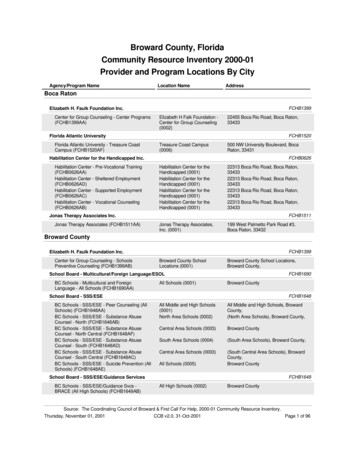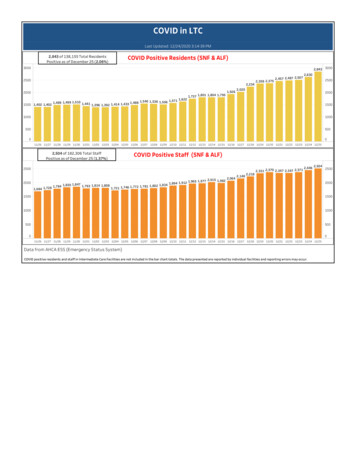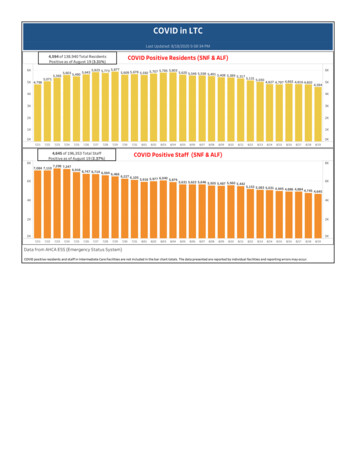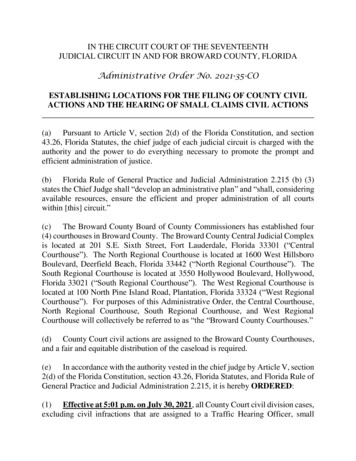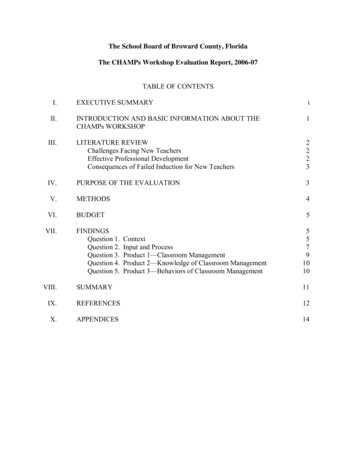
Transcription
The School Board of Broward County, FloridaThe CHAMPs Workshop Evaluation Report, 2006-07TABLE OF CONTENTSI.EXECUTIVE SUMMARYiINTRODUCTION AND BASIC INFORMATION ABOUT THECHAMPs WORKSHOP1III.LITERATURE REVIEWChallenges Facing New TeachersEffective Professional DevelopmentConsequences of Failed Induction for New Teachers2223IV.PURPOSE OF THE SQuestion 1.Question 2.Question 3.Question 4.Question 5.ContextInput and ProcessProduct 1—Classroom ManagementProduct 2—Knowledge of Classroom ManagementProduct 3—Behaviors of Classroom ICES14
The School Board of Broward County, FloridaThe CHAMPs Workshop Evaluation Report, 2006-07Executive SummaryFirst implemented in the 2002-03 academic year, Broward County Public Schools (BCPS)continues to implement the Conversation, Help, Activity, Movement, Participation, and Signal(CHAMPs) workshop for newly hired instructional staff. CHAMPs is a process developed byDr. Randy Sprick to manage classroom behaviors and create a positive, proactive environment toincrease the success of all students. During the 2006-07 school year, six CHAMPs workshopsessions were conducted, with a total of 843 participants (808 from BCPS and 35 fromneighboring charter and private schools). The purpose of this program evaluation is to assess theimplementation and outcome of CHAMPs using the context, input, process, and product (CIPP)model. Topics evaluated address participant demographics, satisfaction of program delivery,perception of impact on classroom and behavior management, and knowledge.The CHAMPs workshops were implemented six times over the 2006-07 school year to meet theneeds of newly hired staff. A careful review and synthesis of the information contained inplanning documents, tools developed by staff to aid implementation, the sequence of the sixworkshops over the school year, and the data from the online participant survey confirmedthat the CHAMPs program was successfully implemented as designed. Online survey datarevealed CHAMPs participants’ satisfaction with the objectives, organization, and materials ofthe workshop. Over two-thirds of the participants agreed that the components of the CHAMPsworkshop helped with classroom management, to answer students’ questions efficiently, andclearly state the task/objective of an activity. Pre- and posttest data verified a positive impact onparticipants’ classroom management knowledge and behaviors.Further improvement in the CHAMPs program may be realized with additional Districtresources. This could result in additional follow-up activities to help participants implementwhat they learned, allocation of additional time to the current one-day training, and reduction insession size to provide individualized learning. Finally, the District would be better served, ifCHAMPs was incorporated in a larger context of successful professional development.Participants relayed that fellow teachers did not practice CHAMPs management components,therefore, trainees needed more help and follow-up to implement these ideas. Ideally, allprofessional development activities should move in the same direction. To maximize CHAMPs’impact, it must be integrated as a component of the larger District professional developmentprogram, so that all new teachers will continue to be exposed to the same set of ideas and receiveassistance as a convergent force of influence.The evaluation data from multiple sources suggested that the CHAMPs workshop made asignificant impact on participants’ knowledge and behavior related to classroom management.The following are the recommendations to be considered during the 2007-08 school year, forfurther improvement that may require additional resources from the District as a necessarycondition for implementation.i
Recommendations1. The Associate Superintendent of Human Resource Development will considerincorporating CHAMPs into a larger context, so that new teachers discern the connectionof the workshop with overall plans for professional development.2. As the lowest workshop survey rating suggested that follow-up activities could bestrengthened, CHAMPs program staff will provide additional follow-up activities toassist participants to implement what they learned.3. Given that many participants felt the time of the workshop was not enough for usefulcontent and delivery, CHAMPs program staff will allot to training more than the currentone-day.4. CHAMPs program staff will reduce session size, so that the learning will beindividualized and personal.5. CHAMPs program staff will revise online survey questionnaire; Question 18 to includeall ethnic groups.ii
The School Board of Broward County, FloridaThe CHAMPs Workshop Evaluation Report, 2006-07IntroductionBroward County Public Schools (BCPS) implemented the Conversation, Help, Activity,Movement, Participation, and Signal (CHAMPs) training project for newly hired teachers in the2002-03 school year. CHAMPs is a process developed by Dr. Randy Sprick to manageclassroom behaviors and create a positive, proactive environment to increase the success of allstudents. Dr. Sprick is a well-known author of several behavior management programs thatcollectively are referred to as the Safe and Civil Schools Series. Through individual studentplans and focus, Dr. Sprick creates a multi-tiered approach to problem solving in interventiondesign. Included in the process are classroom and behavior management principles; and the useof a modular series of materials designed to help the classroom teachers develop (or fine tune) aneffective classroom management plan that is proactive and positive.CHAMPs continues to be implemented in BCPS through the Office of Prevention Programs, as ameans to address issues related to violence prevention and create a classroom culture that assistsstudents and staff to feel safe and secure. CHAMPs was expected to prevent and/or decreasebehavior issues in the classroom that took time and energy away from academics. The CHAMPsworkshop consisted of a one-day, six-hour training session and the dissemination of theCHAMPs text by Sprick, Garrison, and Howard (1998). The training included teacher-directedactivities, cooperative learning, independent work, and pair sharing. The job-embedded activityrequired participants to implement strategies of their choice from the CHAMPs workshop duewithin one month of the training. Participants were required to independently prepare, and returnto the Office of Prevention Programs, detailed notes concerning the implementation of theselected strategies on a visual organizer found at the back of each module (chapter) in the texttitled Self-Assessment Checklist.The CHAMPs workshop covered the content from the first four modules of the CHAMPstext: Module 1: Vision, Module 2: Organization, Module 3: Teaching Expectations, andModule 4: The First Month of School. The four primary District trainers attended a train-thetrainer workshop facilitated by Dr. Sprick in Portland, Oregon. The primary trainers then createda BCPS train-the-trainer program, following the six hour format. They trained 13 additionalDistrict trainers to deliver the CHAMPs workshop, during the first day of a five-day new teacherorientation.Six sessions were delivered, as a part of the New Teacher Academy (NTA) in 2006-07, to 843newly hired instructional participants (808 from BCPS and 35 from neighboring charter andprivate schools). Depending on the date hired, teachers attended the next available NTA—mostwere hired before the academic year began (August) and attended any of the three sessions inJuly. Late hires attended the sessions after their respective hiring in August 2006, October 2006,or February 2007. During the training, the teachers were trained in homogeneous groups byteaching level (e.g., primary elementary, intermediate elementary, etc.). During training,participants interacted with each other at various levels including pairing, group work, andcooperative learning. Networking and support groups were encouraged to assist the teachers inimplementation of CHAMPs strategies in the classroom.1
In the process of designing and implementing the CHAMPs workshop, staff developed materialsto help with design and implementation. For example, staff members were conscientious ofestablishing links between CHAMPs and other school districts’ initiatives (Appendix A) anddevelopment of observation tools for classroom visitation (Appendix B).Literature ReviewChallenges Facing New TeachersNew teachers face many challenges—working with new teachers for a smooth and successfulprofessional transition is a significant challenge. Roehrig, Pressley, and Talotta’s (2002) Storiesof Beginning Teachers in First-Year Challenges and Beyond by Kilburg (2004) began with:For many new teachers, their first three years are probably the most stressful times intheir teaching careers (Martin, Chiodo, and Chang, 2001, p. 55). Working in a newenvironment, examining old beliefs, working with an unfamiliar population, and trying tomanage a level of confidence at times may seem like an endless task (Veeman, 1984).Historically, these concerns tend to be quite universal. Whether you are in theUnited States or in another country, the challenges are essentially the same (Martin,Chiodo, and Chang, 2001). Regardless of the nature of these challenges, beginningteachers tend to have more classroom-related problems than teachers who have beenteaching for longer periods of time. That is why it is so critical for teacher traininginstitutions and school districts to provide the necessary resources for the new teachers tobecome effective and successful in the profession.Veeman’s (1984) research, a comprehensive review of challenges facing new teachers and aclassic on this particular topic, suggested eight frequently encountered challenges for beginningteachers: (a) classroom discipline, (b) motivating students, (c) working with individualdifferences, (d) evaluating students’ work, (e) interacting with parents, (f) organizing classroomwork, (g) insufficient and/or inadequate supplies and materials, and (h) dealing with problems ofindividual students.Effective Professional DevelopmentDarling-Hammond (1995), a leading scholar of education, summarized many studies onprofessional development and listed the following features for professional developmentactivities that improve teaching and lead to higher student achievement. Experiential—engages participants in concrete tasks; Grounded in participants’ questions, inquiry and experimentation, as well asprofession-wide research; Collaborative—involves sharing of knowledge among educators; Sustained and intensive—supported by modeling, coaching, and problem solving aroundspecific problems of practice; and Connected to other aspects of school change.The above list provides a solid guide to developing effective professional developmentprograms. Waters et al. (2003, 2004, 2005) illustrated that professional development activitiesshould address knowledge and skills at different levels, ranging from (a) experiential—knowingwhat is important and why, to (b) declarative—knowing what to do, (c) procedural—knowing2
how to do it, to (d) contextual—knowing when to do it. Other scholars emphasized mentoring,while peer mentoring was found to be an effective strategy for learning and professionaldevelopment (e.g., Costa & Garmston, 1994; Evered & Selman, 1989; Randels, Carse, & Lease1992; Schneider, 1989). Educators’ work is contextual (Tucker & Codding, 2002), so a mentoris particularly important as is the concept of learning communities. Learning communities thatinclude cross-subject and cross-grade professionals prove to be an effective strategy forprofessional development (Grossman & Wineburg, 1999; Grossman, Wineburg, & Woolworth,2001). Finally, professional development should take into account effective adult learning andthe context of school change (e.g., Donaldson, 2001; Fullan, 2001; Merriam & Caffarella, 1999;Tennant & Pogson, 1995).Another powerful concept related to new teachers’ professional development is induction. Wongand Wong (2003) summarized the following as Elements of a Successful Induction Program. Begin with an initial four or five days of training in classroom management and effectiveteaching techniques before school begins. Offer a continuum of professional development through systematic training over a periodof two or three years. Provide study groups so that new teachers can network and build support, commitment,and leadership in a learning community. Incorporate a strong sense of administrative support. Integrate a mentoring component into the induction process. Present a structure for modeling effective teaching during in-services and mentoring. Provide opportunities for inductees to visit demonstration classrooms.Consequences of Failed Induction for New TeachersOne of the consequences for failed induction for new teachers is high attrition rate. A national,five-year longitudinal study shows that new teachers’ attrition rate is extremely high particularlyduring the first three years (Shen & Palmer, 2005). The national longitudinal study revealed that19 percent of new teachers left the teaching force by the end of the first year, 28 percent by theend of the second year, 37 percent by the end of the third year, 41 percent by the end of thefourth year, and 45 percent by the end of the fifth year. Teachers with inadequate preparationwere more likely to leave teaching. Consequently, the inability to manage the classroom was amajor factor contributing to that attrition. High attrition disrupts the functioning of the schoolsystem, negatively impacts student learning, increases the cost for the school district, anddecreases the morale for the teaching force (Shen, 1997a, 1997b). Therefore, failed induction fornew teachers has severe consequences manifested in many different ways.Purpose of the EvaluationThe purpose of this program evaluation is to assess the implementation and outcome of theCHAMPs program. Specifically, this evaluation utilized the context, input, process, and product(CIPP) model and addresses the following five evaluation questions: Question 1: Context—What are CHAMPS participants’ demographic and professionalcharacteristics? Question 2: Input and Process—To what extent are participants satisfied with the contentand delivery of CHAMPs? What are the perceived strength and weakness in content anddelivery?3
Question 3: Product 1—How did the participants perceive the impact of CHAMPs ontheir classroom management?Question 4: Product 2—Has CHAMPs made a significant impact on participants’knowledge of classroom management?Question 5: Product 3—Has CHAMPs made a significant impact on participants’classroom management behaviors?MethodsThis program evaluation includes qualitative evaluative techniques to address process areas.Research questions concerning the CHAMPs program were addressed using descriptive andquantitative methods. To gather pertinent information, combinations of approaches were utilizedincluding: a literature review, observations by program staff, document review, and dataanalysis. To ascertain CHAMPs implementation and satisfaction, an online survey was devisedto capture the responses of the workshop participants. In addition to data collected from newteacher participants and CHAMPs staff, data related to participants’ demographic andprofessional characteristics were extracted from the District Data Warehouse. The followingdescribes the major data sources and the instruments used.Pre- and post-assessment of participants’ knowledge of classroom management. Among the 843CHAMPs participants, 654 completed pre- and posttests concerning classroom knowledge andmanagement. The data were systematically collected by the program staff before and afterCHAMPs workshops, using an instrument with a high level of content validity (Appendix C).The data were analyzed via repeated measure analysis of variance (ANOVA). The ANOVA is atest of the statistical significance of the differences among the mean scores of two or moregroups on one or more variables.Pre- and post-assessment of participants’ behavior related to classroom management. Amongthe last cohort, 24 participants were observed by program staff, before and after the CHAMPsworkshop, for classroom management behaviors. Pre- and post data were available for 17 of theparticipants, using an observation instrument with high content validity (Appendix D). Repeatedmeasure ANOVA were conducted on the 17 pairs of pre- and post data points.Online survey of CHAMPs participants. In consultation with CHAMPs staff, the externalevaluator developed a 21-item measurement, focusing on participants’ program satisfaction, aswell as perception of strengths and suggestions for the program (Appendix E). Participants werenotified by program staff of the survey link via e-mail. Among the 731 invited participants,277 responded to the online survey for a response rate of 38 percent.Data file from the District database. Participants’ (n 795) demographic data and professionalcharacteristics, as listed in the following variables, were extracted from the District DataWarehouse. Name and employee ID number Certification status Gender Staff retention/attrition as of May 7, 2007 Race and ethnicity Years of experience working in BCPS Age Total years of experience in education Highest academic degree4
Documents from and interactions with the CHAMPs staff. Document review included thetextbook by Dr. Sprick and his colleagues, as well as CHAMPs planning and implementationdocuments. Written responses were provided to the evaluators’ questions concerning design andimplementation of the CHAMPs workshop. The evaluator interaction with CHAMPs staffincluded conference calls and more than 20 e-mail communications. It was not easy forCHAMPs staff to implement the programming activities, and at the same time, weave evaluationactivities into grant implementation; however, CHAMPs staff was successful in facilitating theevaluation activities.BudgetThe data for the CHAMPs budget and expenditure are displayed in Table 1. Program fundingpasses through from the Safe and Drug-Free Schools Grant. The CHAMPs budget for 2006-07was 25,141 while expenditures totaled 22,978 for an overage of 2,163.Table 1Summary of CHAMPs Budget and Expenditures, 2006-07aCategorySalaries/benefitsContractual expensesTravelSupplies/equipmentOtheraIndirect costsTotalBudget ( )12,00010,0002002,500n/a44125,141Expenditure ( )10,00010,0001002,500n/a37822,978Includes registration/tuition, room rental, bus transportation, and printing.FindingsThe commonly used CIPP model provided a concise framework for this program evaluation.Five evaluation questions were posed, with foci on (a) content, (b) input, (c) process, and(d) product.The following is a display of the evaluation data in relation to the five evaluation questions.DemograhicsQuestion 1: Context—What are CHAMPs participants’ demographic and professionalcharacteristics?The 2006-07 data for the CHAMPs participants’ demographic and professional characteristicsare presented in Tables 2 and 3. Participants from charter schools or those with missing datawere not included. As seen in Table 2, 795 participants came from more than 198 BCPS; overthree-fourths (78%, n 618) were women, and nearly half (48%, n 394) were 30 years of age oryounger. A large percentage of the participants (49%, n 389) were minorities.5
Table 2CHAMPs Participants’ Demographics by Gender, Race/Ethnicity, and AgeFirst-Year ParticipantsDemographicGenderFemaleMaleRace and EthnicityAsianBlackHispanicNative AmericanWhiteAge 60 years old51–6041–5031–40 4795110162548100Table 3 indicates that two out of 795 CHAMPs participants were not certified, and most (91%,n 724) earned bachelor’s or master’s degrees. Nearly all (98%, n 776) were BCPS new hires.Seventy-one percent (568) had less than one year in teaching, while 208 (26%) of were newBCPS hires with some teaching experience elsewhere. As of May 7, 2007, 731 (92%, n 731)were active; the remainder (8%, n 64) were inactive, retired, or terminated.Table 3CHAMPs Participants’ Professional CharacteristicsCharacteristicsCertification StatusCertifiedWaiting for FDOE issuanceNot certifiedHighest DegreeAssociate degreeBachelor’s degreeMaster’s degreeDoctoral degree (Ed.D., Ph.D., etc.)OtherMissingTotal Years of Teaching ExperienceLess than 1 year1–56–1011 or 59(table continues)6
Table 3 (continued)CharacteristicsYears of BCPS Teaching ExperienceLess than 1 year1–56–1011 or moreStaff Status as of 1998101731625679592107100Participant SatisfactionQuestion 2: Input and Process—To what extent are participants satisfied with the content anddelivery of CHAMPs? What are the perceived strength and weakness in content and delivery?A 21-item survey questionnaire was developed and posted online. CHAMPs staff alertedparticipants via e-mail, and followed with two reminders. The survey was conducted in mid tolate May 2007. Of the 731 participants invited, 277 completed the online questionnaire, for areturn rate of 38 percent. Among the respondents, 80 percent (n 222) were women, and56 percent (n 156) were White.The online survey data in Table 4, indicated that participants were satisfied with the statedobjectives (92%, n 254), and the well-organized (90%, n 248) and effective delivery(88%, n 243) of workshop content. Teachers reported that the workshop was relevant (84%,n 233), presentations were engaging (83%, n 231), handouts added important information(79%, n 220), examples and exercises were relevant (79%, n 218), and the workshop wasintegrated with other aspects of their professional development activities (76%, n 209). Overhalf of the respondents (56%, n 156) suggested that follow-up activities were helpful.Table 4CHAMPs Survey Respondents Agreeing with the Following StatementsStatementsObjectives were clearly stated.Content was well organized.Instructors were effective in delivering content.Information was relevant to me as a teacher.Presentations were engaging.Handouts added important information to me as a teacher.Examples and exercises were relevant to me as a teacher.Workshop was integrated with other aspects of my professional development activities.Follow-up activities were helpful to me as a 797656
Perceived Workshop StrengthsThe respondents’ verbatim responses can be found in Appendix F. The following examples wereextracted from the first ten participants completing the online survey concerning workshopstrengths. Kept us engaged and moving. Good questions, activities, and interactions between teachers and participants. The Book; and interactive instruction. Engaging; easy application; and very focused. The signal was the best solution to getting students’ attention. The laminated chart issomething I use every day in my classroom. The acronym is easy to remember. The instructors, materials, and location. Learning what each acronym meant and how to apply them in the classroom; examples toapply in classroom; posters included for the application of CHAMPs within theclassroom; and the Manual. Conveyed my expectations to my students; helped my students with a visual reminder ofexpectations; and helped with classroom behavior management. Teachers talking about their own experiences. Organizational tool to help guide you and the children through expectations of the lesson;visual reminder of what is required of the students; and communication of objectives.A few patterns emerged from participants’ qualitative comments. Respondents provided positivecomments for the following aspects of the workshops: (a) knowledgeable instructors,(b) engaging presentations, (c) useful and practical content, (d) hearing from experiencedcolleagues, (e) interaction with fellow new teacher, and (f) useful handouts and other materialssuch as the poster. The following typical positive quotes reflected the above themes. Informative, practical, and provides techniques to help students. Presentations were professional, sessions were generally engaging, and interactive toolsthat can be implemented immediately. Well organized, presented with enthusiasm, and clear objectives. Instrumental in helping with introduction and modeling expected behaviors. The largechart is a great visual and point of reference for students and teachers. The CHAMPssystem greatly helps new teachers to focus and organize a lesson. The concept, organization, and results. Clarity, simplicity, relevance. Clear communication from trainers, hands-on activities, and poster for my class.Workshop SuggestionsGiven the opportunity for participants to make suggestions for improving the CHAMPsworkshop, the following themes emerged: (a) more time for training, (b) providing morerelevance to secondary and special education teachers, (c) additional follow-up activities,(d) more help with practice, and (e) smaller sessions. Verbatim suggestions to improve theCHAMPs workshop may be found in Appendix G.8
Perceptions for improvement from CHAMPs staff for design, implementation, and improvementThe CHAMPs staff provided the evaluator with the written response below concerning theirperceptions of the workshops’ strengths, facilitator/barrier, and suggestions for improvement.During informal conversations, teachers revealed that CHAMPs helped organize theirclassroom and effectively orchestrated strategies to increase student time on task.Participants reported that students have less confusion and conflict understanding what isexpected from them to be successful. In classrooms where CHAMPs was employed,expectations were clear and posted and teachers quickly pre-corrected misbehaviors orhandled them without disturbing the flow of instruction. In schools where teachersimplement CHAMPs as a team approach, teachers confirmed more consistency inaddressing behaviors from classroom to classroom with greater communication amongteachers.Indications are that the staff was conscientious in designing, implementing, and improving theCHAMPs workshop. Reflecting on the facilitators and barriers of the workshop, staff indicatedfacilitators included (a) passionate trainers, (b) well-received training, (c) District support,(d) easy-to-use materials, and (e) prepared PowerPoint for universal training. The barriersperceived by the staff included lack of resources for coaching and too few District trainers.Staff’s reflection was in congruence with those of the participants. The staff reported thefollowing strategies for improving the program: (a) increased hands-on activities, so teachersobtain products to use in the classrooms; (b) follow-up that includes coaching and ongoingsupport for teachers; (c) alternate forms of support, including newsletters, Web sites, groupe-mails, instructional support groups, mini in-services, etc.; and (d) implementing the programschool wide or team wide to increase collaboration and coordination of teachers.Question 3: Product 1—How did participants perceive the impact of CHAMPs on theirclassroom management?The data in Table 5, gleaned from the online survey, indicated that over two-thirds (68%, n 187to 74%, n 205) of the participants agreed that a component of the CHAMPs workshop helpedwith their classroom management. Percentages ranged from 68 percent (helped me to answerstudents’ questions efficiently) to 74 percent (helped me to clearly state the task/objective of anactivity).Table 5Survey Respondents Agreed on the Impacts of the Workshop, as Indicated by Help, as Defined bythe CHAMPs AcronymStatementsThe C helped me to monitor student conversation.The H helped me to answer students’ questions efficiently.The A helped me to clearly state the task/objective of an activity.The M helped me to facilitate students’ movement during activities.The P helped me to facilitate students’ active and responsible participation.The s helped me to create a safety signal for my students.9n192187205193190193%696874706970
Data in Figure 1 illustrates the overall impact of the CHAMPs workshop on participants’teaching, as indicated by survey responses. Nearly three-fourths (73%, n 202) agreed that theworkshop was effective in improving teaching practice (16%, n 45 were not sure and 11%, n 30chose disagree).11% (n 30)16% (n 45)73% (n 202)AgreeNot SureDisagreeFigure 1. Overall, the CHAMPs workshop was effective in improving my teaching practice.Question 4: Product 2—Has CHAMPs made a significant impact on participants’ knowledge ofclassroom management?Table 6 displays the pre- and post-means of participants’ self perceptions of their knowledge ofclassroom management. Of the 843 participants, 542 completed pre- and posttests for this item.The data for this table were collected by program staff before and after the CHAMPs workshop.The results indicated that participants significantly improved knowledge of classroommanagement as statistically measured by pre- and posttests. The pre-mean was 2.5, while thepost-mean was 16.0 on a 20-point scale. The p value (probability from 0 to 1) was less than.001, with eta square (estimate of the size of the effect) of .904, and observed power of 1.00.Therefore, CHAMPs appeared to have a statistically positive impact on participants’ knowledgeof classroom management.Table 6Pre- and Posttests (Repeated Measure ANOVA) of Knowledge on Classroom ManagementPre-meanPost-meanObserved powerFpEta square2.516.06,160.1 .001.9041.00Note. See Appendix C for the instrument; n 542.Question 5: Product 3—Has CHAMPs made a significant impact on participants’ classroommanagement behaviors?Among the last cohort, 24 participants were observed by program staff for
The School Board of Broward County, Florida The CHAMPs Workshop Evaluation Report, 2006-07 TABLE OF CONTENTS I. EXECUTIVE SUMMARY i II. INTRODUCTION AND BASIC INFORMATION ABOUT THE CHAMPs WORKSHOP 1 III. LITERATURE REVIEW 2 Challenges Facing New Teachers 2 Effective Professional Development 2 Consequences of Failed Induction for New Teachers 3 IV.



